A Framework for Resilient City Governance in Response to Sudden Weather Disasters: A Perspective Based on Accident Causation Theories
Abstract
:1. Introduction
1.1. Chinese Cities Will Face More Frequent Weather Disasters
1.2. China Introduced the Concept of Resilient City
2. Literature Review
2.1. Urban Resilience and Urban Disaster Risk
2.2. Resilient Cities and Sponge Cities
3. Research Methods and Accident Replay
3.1. Research Methods
3.2. A Brief Introduction to Zhengzhou
3.3. Accident Reply
4. Results Analysis
4.1. The Swiss Cheese Model
- Environmental factors (Natural system)
- 2.
- Management factors (Man-made system)
- The government of Zhengzhou failed to recognize the unique characteristics of the region, lacked effective disaster prevention measures, and had weak emergency response and management capabilities. Furthermore, disaster prevention deployment was incomplete, and warning and response actions were delayed. Consequently, many citizens were unaware of the danger posed by the heavy rainfall and chose to return home by public transportation without caution.
- Zhengzhou Metro Group Co. has inadequate emergency response capabilities, evidenced by a lack of understanding of the maximum risk subway equipment can withstand. This has caused poor decision-making and inadequate risk screening. For instance, despite red warnings of heavy rainfall from 19–20 July, Zhengzhou Metro Group Co. failed to strengthen inspections or recognize the potential danger of flooding. Furthermore, it was not until people were trapped in the metro for over an hour that the Zhengzhou Metro Branch reported to Zhengzhou Metro Group Co.
- The inadequate resources and coordination caused a delayed response to the disaster. Trapped passengers sent out distress signals via social media and emergency hotlines, but had to wait several hours before the rescue teams arrived. Flooded tunnels further hindered the progress of the rescue teams, leading to a delayed response.
- 3.
- Security risk factors (Technical system)
- Unauthorized changes to the railway line design by Zhengzhou Metro Group Co. without approval caused subsidence of 1.973 m near the Wulongkou parking lot, violating Metro Design Code and not reported to regulatory authorities. This depression was prone to waterlogging, resulting in a breach of the waterproof wall and flooding of the subway entrance. The train was forced to stop between Haitansi Station and Shakoulu Station.
- The waterproof walls in the Wulongkou parking lot have no ability to withstand flooding. Some waterproof walls were not high enough due to miscalculations; others were of poor quality because of not built according to the original drawings; and others were replaced with temporary construction fences. Overall, the inadequate supervision by Zhengzhou Metro Group Co. led to the wall’s collapse under the weight of the heavy rain.
- The drainage ditch near the Wulongkou parking lot was not functioning properly due to ineffective management and infractions of regulations, including the installation of a 58-m-long cover plate and the accumulation of construction waste. These factors led to the waterlogging and flooding that occurred in the parking lot during the rainstorm.
- The accident highlighted the lack of safety features in Zhengzhou subway tunnel and vehicles, notably the lack of escape doors and inadequate emergency resources. This caused passengers and staff to pull open cab and carriage doors to exit and impeded air circulation. And the flooding impeded rescue efforts by pushing the train off the tracks, creating a distance of more than 2 m between the train and escape path.
- 4.
- Unsafe behavior factors (Human system)
- The Zhengzhou government’s response to severe weather warnings was inadequate; despite the Central Weather Station issuing consecutive red warnings of heavy rainfall, the government failed to suspend work and school activities in a timely manner. On 20 July, the second red warning was issued at 6 a.m., yet no measures were taken to protect citizens from potential flooding and other hazards. This negligence exposed the public to unnecessary risks.
- The government and transport authorities’ inadequate response to the emergency was highlighted, with Metro Line 5 remaining open when other lines shut down at 17:00 p.m., despite severe weather. The Transport Commission and Emergency Management Bureau failed to consider safety hazards of rail transportation in flooding, disregarding the metro operating company’s request for an emergency shutdown. Prioritizing convenience and accessibility over safety exposed passengers to risks, resulting in the accident.
- The Metro Operating Control Center’s (OCC) poor judgement to emergency situations was revealed by the accident. Their inadequate assessment and response to the emergencies led to mistakes in instructions, such as allowing the train to continue on its route without understanding the risks of flooding in the tunnel, and misdirecting the train to back off 30 m. This resulted in the train losing power and stopping in a lower area.
4.2. Surry’s Model
- The danger formation stage analysis of subway flood
- 2.
- The danger release stage analysis of subway flood
4.3. Trajectory Crossover Theory
- Fundamental causes analysis (Natural system)
- 2.
- Indirect causes analysis (Technical system and Man-made system)
- 3.
- Direct causes analysis
4.4. Comprehensive Analysis
- Natural system
- 2.
- Technical (Equipment) system
- 3.
- Man-made system
5. Discussion
5.1. Resilient City Governance Framework
5.2. Resilient City Governance Recommendations
5.3. Obstacles to Resilient City Implementation
6. Conclusions
6.1. Main Conclusions
- (1)
- The cause of the Zhengzhou Metro accident can be attributed to the interaction of natural, technical (equipment), and man-made systems. In the natural system, the accident was triggered by the combination of the city’s special geographical location, extreme weather conditions, and urban flooding. In the technical (equipment) system, the main causes included illegal changes to the railroad design, lack of inspection of facilities, inadequate investigation of security risks at traffic stations, and unreasonable design of escape plans. In the man-made system, the government and enterprises were both involved. On the government side, there were unsound pre-disaster response measures, inadequate disaster warnings, untimely emergency response, an imperfect emergency plan, and rigid rescue resource management and cooperation. On the enterprise side, the main cause was a lack of emergency management, manifesting in insufficient consideration and preparation of emergency supplies before the disaster, lack of direction and dispatch during the disaster, and delay in rescue timing.
- (2)
- From the perspective of resilient cities, China’s cities exhibit risk governance rigidity in the face of sudden weather disasters and emergencies, and there are deficiencies in natural, technological, institutional, and organizational resilience. The Zhengzhou Metro accident illustrates the fact that China still has a long way to go in the construction of resilient cities. In the process of building resilient cities, China should not adopt a one-size-fits-all approach, but rather should take into account the unique characteristics of each city and harness the collective resources of society to build differentiated, resilient cities. This will require the city government to work closely with various stakeholders, including residents, enterprises, and society organizations, to develop tailored solutions that address the specific vulnerabilities and risks of each city.
- (3)
- The accident highlighted the vulnerability of urban infrastructure to natural disasters, emphasizing the need for urban systems to prioritize disaster preparedness. To improve city resilience in the face of similar disasters, city governments can refer to the resilient city governance framework and recommendations outlined in this paper. Additionally, policy implementation should take into account the potential for complacency, overconfidence, and fatigue to hinder the effectiveness of resilience efforts.
6.2. Limitations and Prospects
Author Contributions
Funding
Institutional Review Board Statement
Informed Consent Statement
Data Availability Statement
Conflicts of Interest
References
- WMO. WMO Atlas of Mortality and Economic Losses from Weather, Climate and Water Extremes (1970–2019) (WMO-No. 1267); WMO: Geneva, Switzerland, 2021. [Google Scholar]
- GFDRR. Natural Disaster Challenges in China: Key Trends and Insights; GFDRR: Washington, DC, USA, 2020. [Google Scholar]
- NBSC. China Statistical Yearbook 2021; NBSC: Sumter, SC, USA, 2022. [Google Scholar]
- Meerow, S.; Newell, J.P.; Stults, M. Defining urban resilience: A review. Landsc. Urban Plan. 2016, 147, 38–49. [Google Scholar] [CrossRef]
- Tang, B.; Qiu, J.; Huang, J.; Zhang, Y.; Qiu, F. Spatial and Temporal Patterns of Urban Vulnerability in Guangzhou. J. Risk Anal. Crisis Response 2021, 9, 101–110. [Google Scholar] [CrossRef] [Green Version]
- Torabi, E.; Dedekorkut-Howes, A.; Howes, M. A framework for using the concept of urban resilience in responding to climate-related disasters. Urban Res. Pract. 2022, 15, 561–583. [Google Scholar] [CrossRef]
- Wardekker, J.A.; de Jong, A.; Knoop, J.M.; van der Sluijs, J.P. Operationalising a resilience approach to adapting an urban delta to uncertain climate changes. Technol. Forecast. Soc. Chang. 2010, 77, 987–998. [Google Scholar] [CrossRef] [Green Version]
- Desouza, K.C.; Flanery, T.H. Designing, planning, and managing resilient cities: A conceptual framework. Cities 2013, 35, 89–99. [Google Scholar] [CrossRef]
- Lu, P.; Stead, D. Understanding the notion of resilience in spatial planning: A case study of Rotterdam, The Netherlands. Cities 2013, 35, 200–212. [Google Scholar] [CrossRef]
- Mehmood, A. Of resilient places: Planning for urban resilience. Eur. Plan. Stud. 2016, 24, 407–419. [Google Scholar] [CrossRef] [Green Version]
- Molin Valdés, H.; Amaratunga, D.; Haigh, R. Making Cities Resilient: From awareness to implementation. Int. J. Disaster Resil. Built Environ. 2013, 4, 5–8. [Google Scholar] [CrossRef]
- Weichselgartner, J.; Kelman, I. Geographies of resilience: Challenges and opportunities of a descriptive concept. Prog. Hum. Geogr. 2015, 39, 249–267. [Google Scholar] [CrossRef] [Green Version]
- United Nations Department of Economic and Social Affairs. The Sustainable Development Goals Report 2018; United Nations: New York, NY, USA, 2018. [Google Scholar]
- Borsekova, K.; Nijkamp, P.; Guevara, P. Urban resilience patterns after an external shock: An exploratory study. Int. J. Disaster Risk Reduct. 2018, 31, 381–392. [Google Scholar] [CrossRef]
- Ribeiro, P.J.G.; Gonçalves, L.A.P.J. Urban resilience: A conceptual framework. Sustain. Cities Soc. 2019, 50, 101625. [Google Scholar] [CrossRef]
- Shamsuddin, S. Resilience resistance: The challenges and implications of urban resilience implementation. Cities 2020, 103, 102763. [Google Scholar] [CrossRef] [PubMed]
- Masnavi, M.; Gharai, F.; Hajibandeh, M. Exploring urban resilience thinking for its application in urban planning: A review of literature. Int. J. Environ. Sci. Technol. 2019, 16, 567–582. [Google Scholar] [CrossRef]
- Naef, P. Resilience as a City Brand: The Cases of the Comuna 13 and Moravia in Medellin, Colombia. Sustainability 2020, 12, 8469. [Google Scholar] [CrossRef]
- Naef, P. Resistances in the “Resilient City”: Rise and fall of a disputed concept in New Orleans and Medellin. Political Geogr. 2022, 96, 102603. [Google Scholar] [CrossRef]
- Büyüközkan, G.; Ilıcak, Ö.; Feyzioğlu, O. A review of urban resilience literature. Sustain. Cities Soc. 2022, 77, 103579. [Google Scholar] [CrossRef]
- Xu, H.; Li, Y.; Tan, Y.; Deng, N. A Scientometric Review of Urban Disaster Resilience Research. Int. J. Environ. Res. Public Health 2021, 18, 3677. [Google Scholar] [CrossRef]
- Silva, A.M.D.; Lazaro, L.L.B.; Andrade, J.C.S.; Prado, A.F.R.; Ventura, A.C.; Campelo, A.; Tridello, V. Examining the Urban Resilience Strategy of Salvador, Bahia, Brazil: A Comparative Assessment of Predominant Sectors Within the Resilient Cities Network. J. Urban Plan. Dev. 2022, 148, 05022002. [Google Scholar] [CrossRef]
- Orsetti, E.; Tollin, N.; Lehmann, M.; Valderrama, V.A.; Morato, J. Building Resilient Cities: Climate Change and Health Interlinkages in the Planning of Public Spaces. Int. J. Environ. Res. Public Health 2022, 19, 1355. [Google Scholar] [CrossRef]
- Ke, K.Y.; Lin, Y.J.; Tan, Y.C.; Pan, T.Y.; Tai, L.L.; Lee, C.A. Enhancing Local Disaster Management Network through Developing Resilient Community in New Taipei City, Taiwan. Int. J. Environ. Res. Public Health 2020, 17, 5357. [Google Scholar] [CrossRef]
- Pirlone, F.; Spadaro, I.; Candia, S. More Resilient Cities to Face Higher Risks. The Case of Genoa. Sustainability 2020, 12, 4825. [Google Scholar] [CrossRef]
- Lu, Y.; Li, R. Rebuilding resilient homeland: An NGO-led post-Lushan earthquake experimental reconstruction program. Nat. Hazards 2020, 104, 853–882. [Google Scholar] [CrossRef]
- Banai, R. Pandemic and the planning of resilient cities and regions. Cities 2020, 106, 102929. [Google Scholar] [CrossRef]
- Wang, F.; Fang, Y.Y.; Deng, H.D.; Wei, F.Z. How community medical facilities can promote resilient community constructions under the background of pandemics. Indoor Built Environ. 2022, 31, 1018–1027. [Google Scholar] [CrossRef]
- Saikia, P.; Beane, G.; Garriga, R.G.; Avello, P.; Ellis, L.; Fisher, S.; Leten, J.; Ruiz-Apilanez, I.; Shouler, M.; Ward, R.; et al. City Water Resilience Framework: A governance based planning tool to enhance urban water resilience. Sustain. Cities Soc. 2022, 77, 103497. [Google Scholar] [CrossRef]
- Xu, W.P.; Kong, Y.L.; Proverbs, D.; Zhang, Y.W.; Zhang, Y.; Xu, J.T. A Water Resilience Evaluation Model for Urban Cities. Water 2022, 14, 1942. [Google Scholar] [CrossRef]
- Maroufi, H.; Borhani, M. A measurement of community seismic resilience in sub-city districts of Mashhad, Iran. J. Environ. Plan. Manag. 2022, 65, 675–702. [Google Scholar] [CrossRef]
- Yin, D.K.; Chen, Y.; Jia, H.F.; Wang, Q.; Chen, Z.X.; Xu, C.Q.; Li, Q.; Wang, W.L.; Yang, Y.; Fu, G.T.; et al. Sponge city practice in China: A review of construction, assessment, operational and maintenance. J. Clean. Prod. 2021, 280, 124963. [Google Scholar] [CrossRef]
- Chan, F.K.S.; Griffiths, J.A.; Higgitt, D.; Xu, S.Y.; Zhu, F.F.; Tang, Y.T.; Xu, Y.Y.; Thorne, C.R. “Sponge City” in China-A breakthrough of planning and flood risk management in the urban context. Land Use Policy 2018, 76, 772–778. [Google Scholar] [CrossRef]
- Wang, H.; Mei, C.; Liu, J.H.; Shao, W.W. A new strategy for integrated urban water management in China: Sponge city. Sci. China-Technol. Sci. 2018, 61, 317–329. [Google Scholar] [CrossRef]
- Jiang, Y.; Zevenbergen, C.; Ma, Y.C. Urban pluvial flooding and stormwater management: A contemporary review of China’s challenges and “sponge cities” strategy. Environ. Sci. Policy 2018, 80, 132–143. [Google Scholar] [CrossRef]
- Nguyen, T.T.; Ngo, H.H.; Guo, W.S.; Wang, X.C.C.; Ren, N.Q.; Li, G.B.; Ding, J.; Liang, H. Implementation of a specific urban water management—Sponge City. Sci. Total Environ. 2019, 652, 147–162. [Google Scholar] [CrossRef]
- Mei, C.; Liu, J.H.; Wang, H.; Yang, Z.Y.; Ding, X.Y.; Shao, W.W. Integrated assessments of green infrastructure for flood mitigation to support robust decision-making for sponge city construction in an urbanized watershed. Sci. Total Environ. 2018, 639, 1394–1407. [Google Scholar] [CrossRef]
- Li, Q.; Wang, F.; Yu, Y.; Huang, Z.C.; Li, M.T.; Guan, Y.T. Comprehensive performance evaluation of LID practices for the sponge city construction: A case study in Guangxi, China. J. Environ. Manag. 2019, 231, 10–20. [Google Scholar] [CrossRef]
- Luan, B.; Yin, R.X.; Xu, P.; Wang, X.; Yang, X.M.; Zhang, L.; Tang, X.Y. Evaluating Green Stormwater Infrastructure strategies efficiencies in a rapidly urbanizing catchment using SWMM-based TOPSIS. J. Clean. Prod. 2019, 223, 680–691. [Google Scholar] [CrossRef]
- Liang, C.M.; Zhang, X.; Xu, J.; Pan, G.Y.; Wang, Y. An integrated framework to select resilient and sustainable sponge city design schemes for robust decision making. Ecol. Indic. 2020, 119, 106810. [Google Scholar] [CrossRef]
- Chan, F.K.S.; Chen, W.Y.; Gu, X.B.; Peng, Y.; Sang, Y.F. Transformation towards resilient sponge cities in China. Nat. Rev. Earth Environ. 2022, 3, 99–101. [Google Scholar] [CrossRef]
- Heinrich, H.; Petersen, D.; Roos, N. Industrial Accident Prevention: A Safety Management Approach; McGraw-Hill: New York, NY, USA, 1980. [Google Scholar]
- Reason, J. Human Error; Cambridge University Press: Cambridge, UK, 1990. [Google Scholar]
- Surry, J. Industrial Accident Research: A Human Engineering Appraisal; University of Toronto: Toronto, ON, Canada, 1969. [Google Scholar]
- Fu, G.; Lu, B.; Chen, X.Z. Jiyu xingwei kexue de zuzhi anquan guanli fang’an moxing (A Model of Organizational Security Management Scheme Based on Behavior Science). China Saf. Sci. J. 2005, 9, 21–27. [Google Scholar] [CrossRef]
- Sui, P.C. Shangwang shigu fenxi yu yufang yuanli (Analysis and Prevention Principles of Casualty Accidents). Yejin Anquan 1982, 1–8. [Google Scholar]
- Yang, Y.H.; Liu, Y.X.; Zhou, M.X.; Li, F.X.; Sun, C. Robustness assessment of urban rail transit based on complex network theory: A case study of the Beijing Subway. Saf. Sci. 2015, 79, 149–162. [Google Scholar] [CrossRef]
- Henan Government. 2021 Nian Henan Sheng Guomin Jingji He Shehui Fazhan Tongji Gongbao (Statistical Bulletin of Provincial Economic and Social Development of Henan Province in 2021). Available online: https://www.henan.gov.cn/2022/03-12/2413033.html (accessed on 29 December 2022).
- Henan Government. 2021 Nian Zhengzhoushi Guomin Jingji He Shehui Fazhan Tongji Gongbao (Statistical Bulletin of National Economic and Social Development of Zhengzhou in 2021). Available online: https://www.henan.gov.cn/2022/03-15/2414591.html (accessed on 29 December 2022).
- Henan Government. Zhengzhou Ditie 5 Hao Xian Shoulieche Xiaxian 2019 Nian Qian Tongche Shiyunying (Zhengzhou Metro Line 5 First Train off the Line before 2019 Commissioning Trial Operation). Available online: https://www.henan.gov.cn/2018/03-12/652859.html (accessed on 29 December 2022).
- MEM. Investigation Report on “7.20” Heavy Rainstorm Disaster in Zhengzhou, Henan; Ministry of Emergency Management: Beijing, China, 2022. [Google Scholar]
- Wu, Y.F.; Cai, L.; Sun, R.; Chao, J.S.; Long, H.; Wang, J.W. Animation Restores the Whole Incident of Zhengzhou Metro Line 5. Available online: https://m.thepaper.cn/api_prom.jsp?contid=13711519 (accessed on 24 September 2022).
- Wei, J.; Wang, J. Hongshui heyi guanjin zhengzhou ditie 5 hao xian (Why Flood Water Poured into Zhengzhou Metro Line 5). Available online: https://www.thepaper.cn/newsDetail_forward_13747267 (accessed on 28 November 2022).
- Pan, J. Zhengzhou Ditie 5 Hao Xian “Jinshui Kou” Diaocha: Zhongsuo Zhouzhi De Wadi, Cengyin Paishui Nengli Cha Bei Yaoqiu Gaizao (Zhengzhou Metro Line 5 “Water Entrance” Investigation: The Well-Known Depression, Once Asked to Renovate Due to Poor Drainage Capacity). Available online: https://baijiahao.baidu.com/s?id=1706407670457925574&wfr=spider&for=pc (accessed on 28 November 2022).
- Peng, C.; Zuo, L. Baoyu Zhong, Tamen Mei Zouwan Huijia De Lu (In the Rainstorm, They did not Finish the Road Home). Available online: https://www.bjnews.com.cn/detail/162712235214206.html (accessed on 28 November 2022).
- Amap. (Zhengzhou Metro Line 5 and Wulongkou Parking Lot). Available online: https://www.amap.com/ (accessed on 28 November 2022).
- Levin, S.A.; Barrett, S.; Aniyar, S.; Baumol, W.; Bliss, C.; Bolin, B.; Dasgupta, P.; Ehrlich, P.; Folke, C.; Gren, I.-M. Resilience in natural and socioeconomic systems. Environ. Dev. Econ. 1998, 3, 221–262. [Google Scholar] [CrossRef]
- Coaffee, J.; Therrien, M.C.; Chelleri, L.; Henstra, D.; Aldrich, D.P.; Mitchell, C.L.; Tsenkova, S.; Rigaud, É.; on behalf of the participants. Urban resilience implementation: A policy challenge and research agenda for the 21st century. J. Contingencies Crisis Manag. 2018, 26, 403–410. [Google Scholar] [CrossRef]
- Heinimann, H.R.; Hatfield, K. Infrastructure resilience assessment, management and governance–state and perspectives. In Resilience and Risk; Springer: Cham, Switzerland, 2017; pp. 147–187. [Google Scholar]
- Rød, B.; Lange, D.; Theocharidou, M.; Pursiainen, C. From risk management to resilience management in critical infrastructure. J. Manag. Eng. 2020, 36, 04020039. [Google Scholar] [CrossRef]
- Meerow, S.; Newell, J.P. Urban resilience for whom, what, when, where, and why? Urban Geogr. 2019, 40, 309–329. [Google Scholar] [CrossRef]
- Woodruff, S.; Bowman, A.O.M.; Hannibal, B.; Sansom, G.; Portney, K. Urban resilience: Analyzing the policies of US cities. Cities 2021, 115, 103239. [Google Scholar] [CrossRef]
- Pursiainen, C. Critical infrastructure resilience: A Nordic model in the making? Int. J. Disaster Risk Reduct. 2018, 27, 632–641. [Google Scholar] [CrossRef]

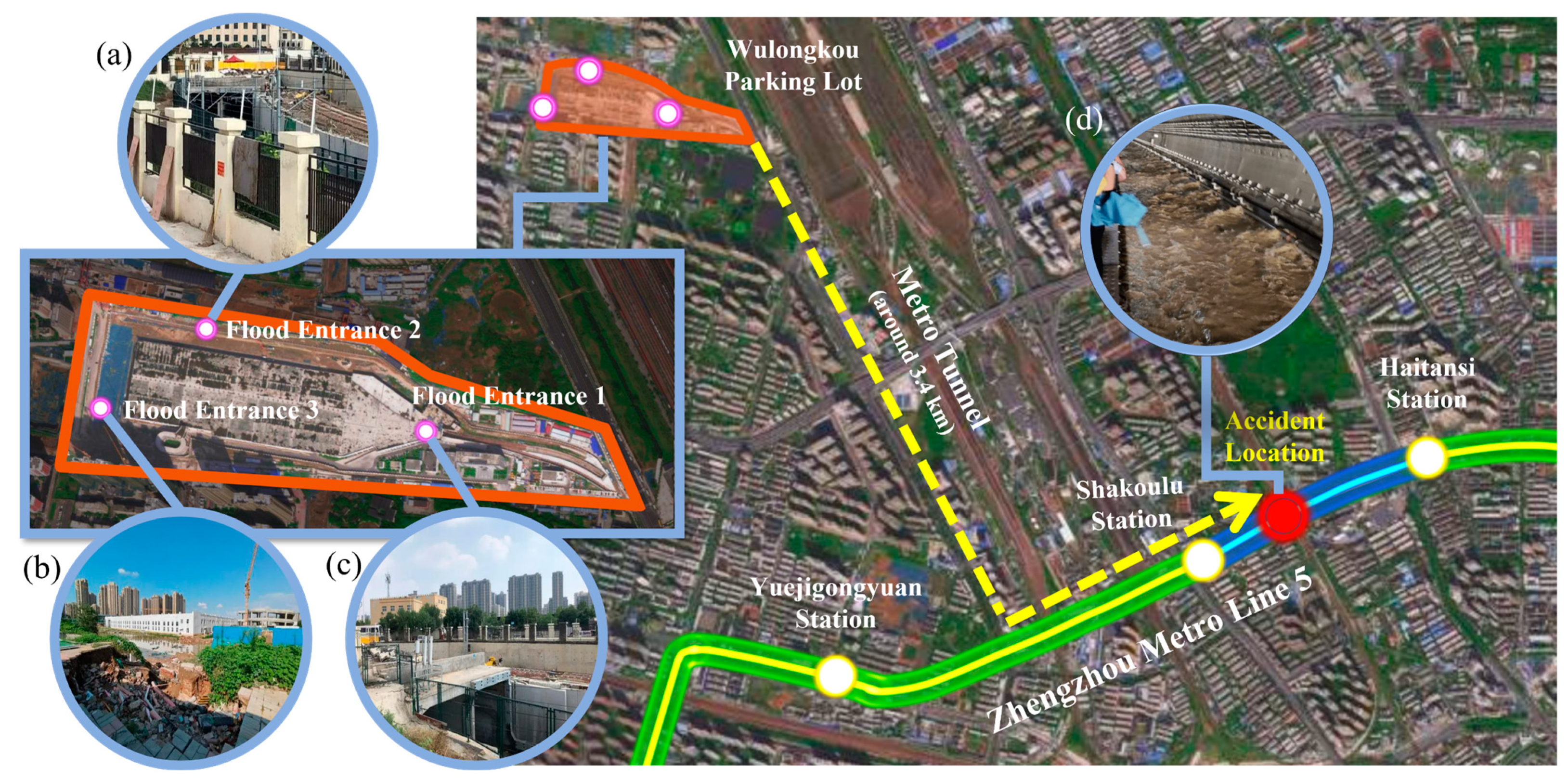

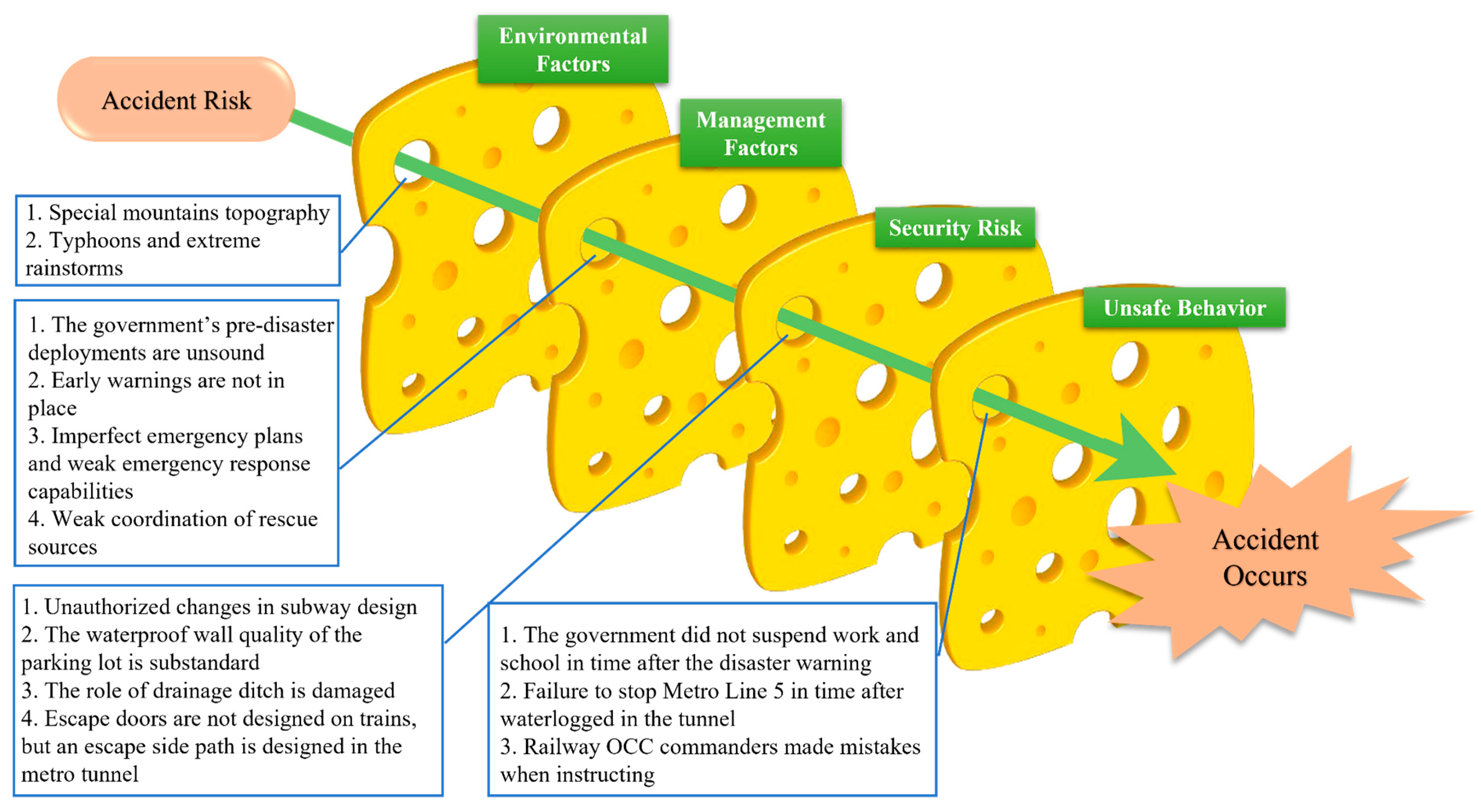
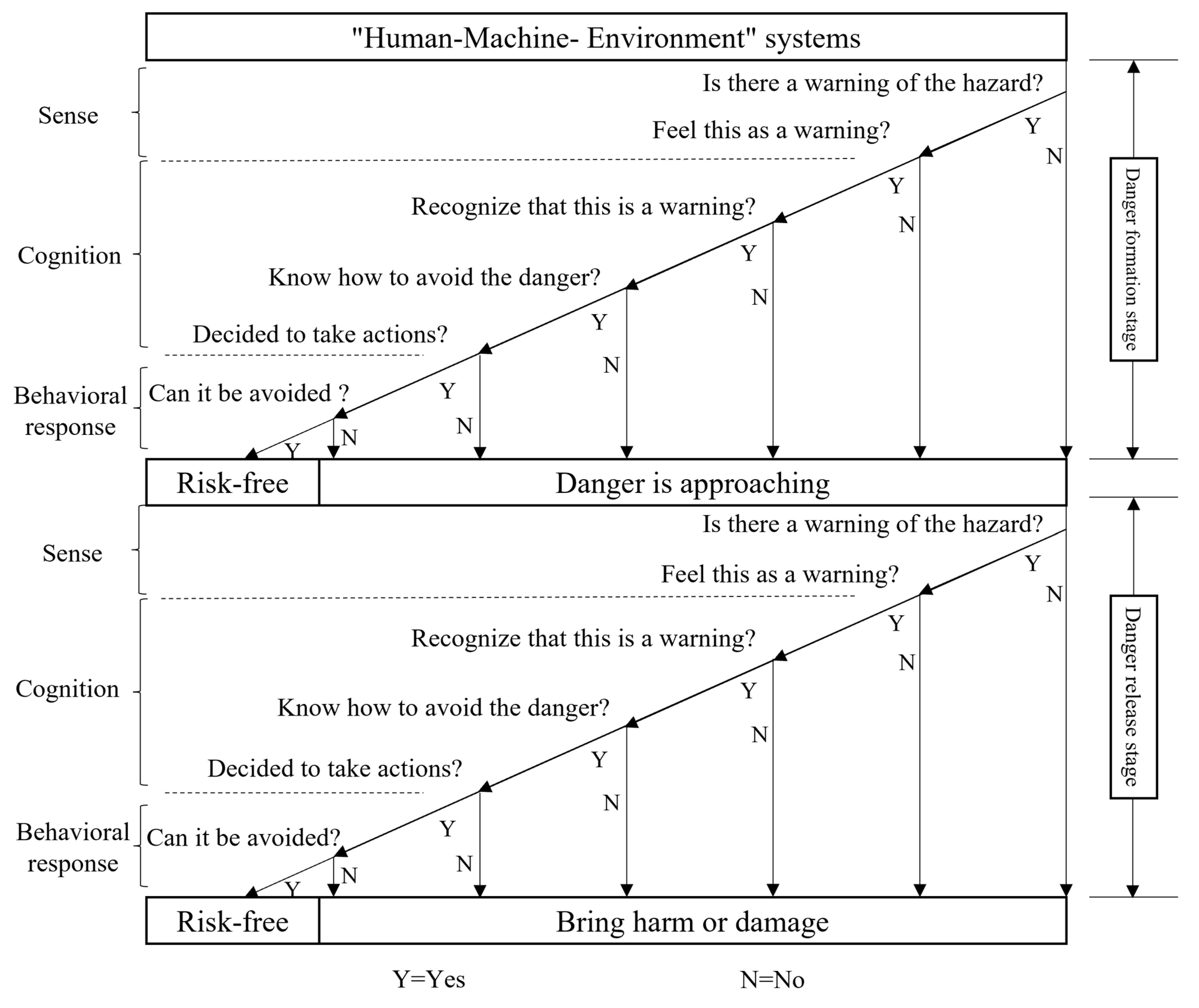
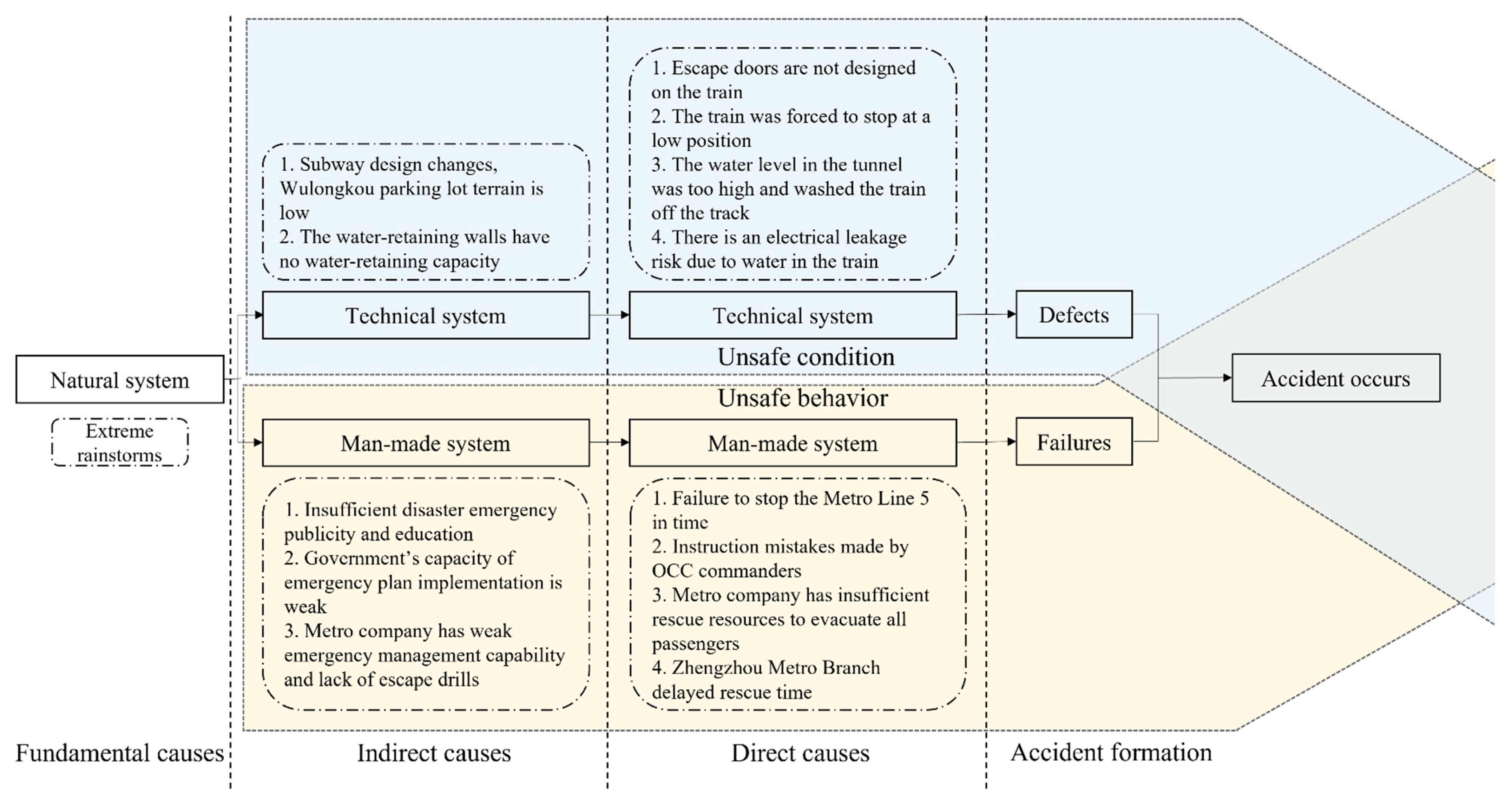
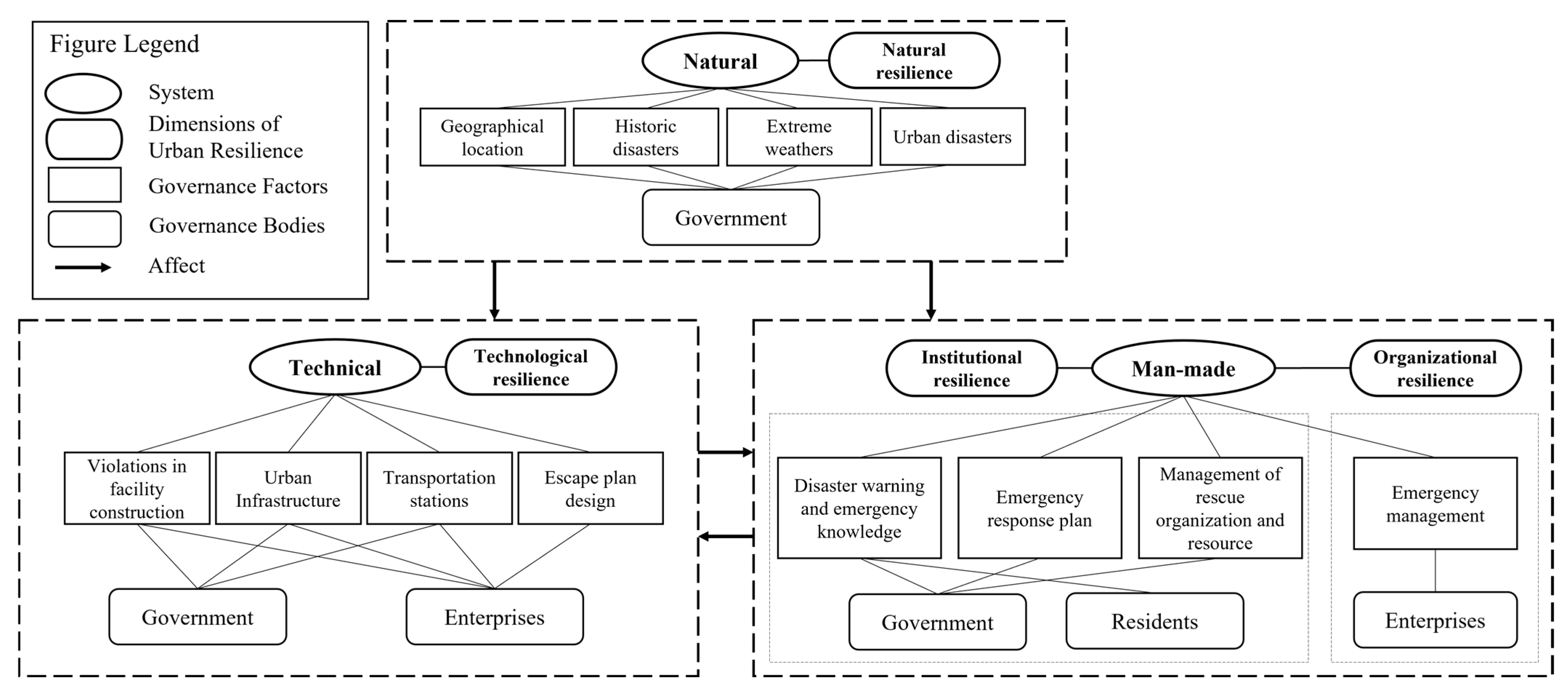
| System | Governance Factors | Dimensions of Urban Resilience | Factors Contributing to the Accident |
|---|---|---|---|
| Natural system | Geographical location | Natural resilience | 1. Stable and strong rainfall in Henan Province due to its geographical location and air pressure |
| Historic disasters | 2. Previous extreme flood events in 1975 | ||
| Extreme weathers | 3. Record-breaking heavy precipitation events due to typhoon | ||
| Urban disasters | 4. Extreme rainstorms cause severe urban flooding. | ||
| Technical (Equipment) system | Violations in facility construction | Technological resilience | 5. Violations in facility construction (e.g., unauthorized changes to design) and inadequate infrastructure (e.g., substandard water retaining fences, insufficient drainage capacity) |
| Urban infrastructure | |||
| Transportation stations | |||
| Escape plan design | |||
| Man-made system | Disaster warning and emergency knowledge | Institutional resilience | 6. Lack of disaster warning and emergency knowledge among citizens |
| Emergency response plan | 7. Weak emergency response plan and capacity of the government | ||
| Management of rescue organization and resource | 8. Lack of coordination between official and unofficial rescue organizations | ||
| Emergency management | Organizational resilience | 9. Mistakes in emergency response actions (e.g., failure to shut down subway line in time, inadequate instructions to train operators) 10. Delays in reporting dangerous situations and inadequate rescue resources |
| Characteristics | Description | |
|---|---|---|
| 1 | Redundancy | Existence of several functionally similar components, so that the system does not fail when one of the components fails. |
| 2 | Diversity | Existence of several functionally different components to protect the system against the various threats. The more diversity the system possesses, the better the ability to adapt to a wide range of diverse circumstances. |
| 3 | Efficiency | Positive relationship between the functioning of a static urban system in relation to the operation of a dynamic system. |
| 4 | Robustness | Ability to resists to attacks or other external forces. Robust design anticipates potential system failures, ensuring that failures are predictable, secure and not disproportionate to the cause. |
| 5 | Connectivity | Connected system components for support and mutual interaction. |
| 6 | Adaptation | Ability to learn from experience and be flexible in the face of change. |
| 7 | Resources | Existence of resources that can be rapidly displaced to respond to disruptions and their effects. |
| 8 | Independence | Ability to operate for a continuous post-disaster period without relying on external physical intervention. |
| 9 | Innovation | Ability to quickly find different ways to achieve goals or meet their needs during a shock, or when a system is under stress. Innovation is critical to developing a city’s ability to restore the functionality of critical systems under severely limited conditions. |
| 10 | Inclusion | Development of broad consultation and involvement of communities, particularly of the most vulnerable groups in the development of processes and plans. An inclusive approach contributed to a joint vision to build the city’s resilience. |
| 11 | Integration | Integration and alignment between urban systems promotes stronger decision-making and ensures that all users/components mutually support each other for a common outcome. The exchange of information between systems allows them to function collectively and respond quickly through shorter response cycles across the city. |
Disclaimer/Publisher’s Note: The statements, opinions and data contained in all publications are solely those of the individual author(s) and contributor(s) and not of MDPI and/or the editor(s). MDPI and/or the editor(s) disclaim responsibility for any injury to people or property resulting from any ideas, methods, instructions or products referred to in the content. |
© 2023 by the authors. Licensee MDPI, Basel, Switzerland. This article is an open access article distributed under the terms and conditions of the Creative Commons Attribution (CC BY) license (https://creativecommons.org/licenses/by/4.0/).
Share and Cite
Xie, Z.; Peng, B. A Framework for Resilient City Governance in Response to Sudden Weather Disasters: A Perspective Based on Accident Causation Theories. Sustainability 2023, 15, 2387. https://doi.org/10.3390/su15032387
Xie Z, Peng B. A Framework for Resilient City Governance in Response to Sudden Weather Disasters: A Perspective Based on Accident Causation Theories. Sustainability. 2023; 15(3):2387. https://doi.org/10.3390/su15032387
Chicago/Turabian StyleXie, Zhenyu, and Benhong Peng. 2023. "A Framework for Resilient City Governance in Response to Sudden Weather Disasters: A Perspective Based on Accident Causation Theories" Sustainability 15, no. 3: 2387. https://doi.org/10.3390/su15032387





